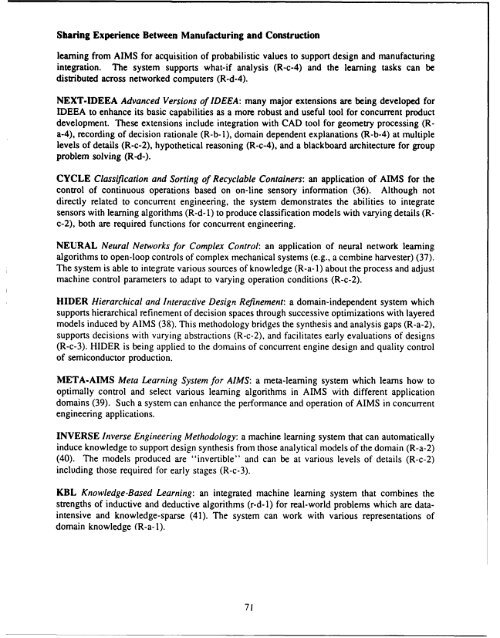Challenges and Opportunities for Innovation in the Public Works ...
Challenges and Opportunities for Innovation in the Public Works ...
Challenges and Opportunities for Innovation in the Public Works ...
You also want an ePaper? Increase the reach of your titles
YUMPU automatically turns print PDFs into web optimized ePapers that Google loves.
Shar<strong>in</strong>g Experience Between Manufactur<strong>in</strong>g <strong>and</strong> Construction<br />
learn<strong>in</strong>g from AIMS <strong>for</strong> acquisition of probabilistic values to support design <strong>and</strong> manufactur<strong>in</strong>g<br />
<strong>in</strong>tegration. The system supports what-if analysis (R-c-4) <strong>and</strong> <strong>the</strong> learn<strong>in</strong>g tasks can be<br />
distributed across networked computers (R-d-4).<br />
NEXT-IDEEA Advanced Versions of IDEEA: many major extensions are be<strong>in</strong>g developed <strong>for</strong><br />
IDEEA to enhance its basic capabilities as a more robust <strong>and</strong> useful tool <strong>for</strong> concurrent product<br />
development. These extensions <strong>in</strong>clude <strong>in</strong>tegration with CAD tool <strong>for</strong> geometry process<strong>in</strong>g (Ra-4),<br />
record<strong>in</strong>g of decision rationale (R-b-1), doma<strong>in</strong> dependent explanations (R-b-4) at multiple<br />
levels of details (R-c-2), hypo<strong>the</strong>tical reason<strong>in</strong>g (R-c-4), <strong>and</strong> a blackboard architecture <strong>for</strong> group<br />
problem solv<strong>in</strong>g (R-d-).<br />
CYCLE Classification <strong>and</strong> Sort<strong>in</strong>g of Recyclable Conta<strong>in</strong>ers: an application of AIMS <strong>for</strong> <strong>the</strong><br />
control of cont<strong>in</strong>uous operations based on on-l<strong>in</strong>e sensory <strong>in</strong><strong>for</strong>mation (36). Although not<br />
directly related to concurrent eng<strong>in</strong>eer<strong>in</strong>g, <strong>the</strong> system demonstrates <strong>the</strong> abilities to <strong>in</strong>tegrate<br />
sensors with learn<strong>in</strong>g algorithms (R-d-1) to produce classification models with vary<strong>in</strong>g details (Rc-2),<br />
both are required functions <strong>for</strong> concurrent eng<strong>in</strong>eer<strong>in</strong>g.<br />
NEURAL Neural Networks <strong>for</strong> Complex Control: an application of neural network learn<strong>in</strong>g<br />
algorithms to open-loop controls of complex mechanical systems (e.g., a comb<strong>in</strong>e harvester) (37).<br />
The system is able to <strong>in</strong>tegrate various sources of knowledge (R-a-1) about <strong>the</strong> process <strong>and</strong> adjust<br />
mach<strong>in</strong>e control parameters to adapt to vary<strong>in</strong>g operation conditions (R-c-2).<br />
HIDER Hierarchical <strong>and</strong> Interactive Design Ref<strong>in</strong>ement: a doma<strong>in</strong>-<strong>in</strong>dependent system which<br />
supports hierarchical ref<strong>in</strong>ement of decision spaces through successive optimizations with layered<br />
models <strong>in</strong>duced by AIMS (38). This methodology bridges <strong>the</strong> syn<strong>the</strong>sis <strong>and</strong> analysis gaps (R-a-2),<br />
supports decisions with vary<strong>in</strong>g abstractions (R-c-2), <strong>and</strong> facilitates early evaluations of designs<br />
(R-c-3). HIDER is be<strong>in</strong>g applied to <strong>the</strong> doma<strong>in</strong>s of concurrent eng<strong>in</strong>e design <strong>and</strong> quality control<br />
of semiconductor production.<br />
META-AIMS Meta Learn<strong>in</strong>g System <strong>for</strong> AIMS: a meta-leam<strong>in</strong>g system which learns how to<br />
optimally control <strong>and</strong> select various learn<strong>in</strong>g algorithms <strong>in</strong> AIMS with different application<br />
doma<strong>in</strong>s (39). Such a system can enhance <strong>the</strong> per<strong>for</strong>mance <strong>and</strong> operation of AIMS <strong>in</strong> concurrent<br />
eng<strong>in</strong>eer<strong>in</strong>g applications.<br />
INVERSE Inverse Eng<strong>in</strong>eer<strong>in</strong>g Methodology: a mach<strong>in</strong>e learn<strong>in</strong>g system that can automatically<br />
<strong>in</strong>duce knowledge to support design syn<strong>the</strong>sis from those analytical models of <strong>the</strong> doma<strong>in</strong> (R-a-2)<br />
(40). The models produced are "<strong>in</strong>vertible" <strong>and</strong> can be at various levels of details (R-c-2)<br />
<strong>in</strong>clud<strong>in</strong>g those required <strong>for</strong> early stages (R-c-3).<br />
KBL Knowledge-Based Learn<strong>in</strong>g: an <strong>in</strong>tegrated mach<strong>in</strong>e learn<strong>in</strong>g system that comb<strong>in</strong>es <strong>the</strong><br />
strengths of <strong>in</strong>ductive <strong>and</strong> deductive algorithms (r-d-1) <strong>for</strong> real-world problems which are data<strong>in</strong>tensive<br />
<strong>and</strong> knowledge-sparse (41). The system can work with various representations of<br />
doma<strong>in</strong> knowledge (R-a-l).<br />
71







